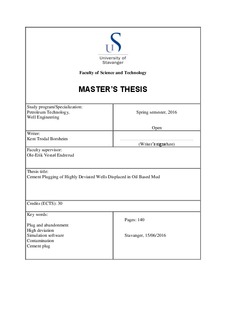| dc.contributor.author | Borsheim, Kent Trodal | |
| dc.date.accessioned | 2016-09-21T09:03:02Z | |
| dc.date.available | 2016-09-21T09:03:02Z | |
| dc.date.issued | 2016-06-15 | |
| dc.identifier.uri | http://hdl.handle.net/11250/2409131 | |
| dc.description | Master's thesis in Petroleum engineering | nb_NO |
| dc.description.abstract | When an oil or gas well is not profitable to produce from anymore, it needs to be temporarily or permanent plugged and abandoned (P&A). These operations are required in order to leave a well secured with sufficient barriers to prevent leakage. With a lot of old wells finishing their useful lifetime and others not able to produce profitably, the need of P&A operations are increasing on the Norwegian continental shelf (NCS).
With increasing number of operations comes increasing number of challenges and problems. One of the most common difficulties in plugging a well in the NCS is when the well is highly deviated. Plugging in the highly deviated areas of the well gives great challenges to the plugging material, mud composure and the plugging technique.
This thesis evaluates the different parameters affecting a cement plug placement in a highly deviated well using oil based mud which creates yet another challenge in avoiding contamination of the cement used. The parameters were thorough investigated and fed into a simulator (“Cementics zonal isolation” from Schlumberger) in order to find out which role the different parameters had in cement plugging of a well in given conditions.
After numerous simulations focusing on the contamination risk at each individual case, it was concluded some results. A deviation angle towards horizontal can be beneficial for less contamination, rather than a deviation angle of 60° which proves to be more exposed to contamination risk. Stinger size and length affect the contamination, and the industry practice with the stinger length being 1.5 times the plug length was confirmed.
Different plugging methods were also simulated against each other, and in a highly deviated well, the two plug method seems to have the best results in terms of contamination and plug length. The effect of dogleg severity (DLS) was also investigated, and though differences were spotted, no conclusion could be made. | nb_NO |
| dc.language.iso | eng | nb_NO |
| dc.publisher | University of Stavanger, Norway | nb_NO |
| dc.relation.ispartofseries | Masteroppgave/UIS-TN-IPT/2016; | |
| dc.rights | Navngivelse 3.0 Norge | * |
| dc.rights.uri | http://creativecommons.org/licenses/by/3.0/no/ | * |
| dc.subject | petroleumsteknologi | nb_NO |
| dc.subject | petroleum engineering | nb_NO |
| dc.subject | cement plug | nb_NO |
| dc.subject | deviated wells | nb_NO |
| dc.subject | cement contamination | nb_NO |
| dc.subject | cementics zonal isolation | nb_NO |
| dc.subject | boreteknologi | nb_NO |
| dc.subject | drilling and well | nb_NO |
| dc.subject | plug and abandonment | nb_NO |
| dc.title | Cement Plugging of Highly Deviated Wells Displaced in Oil Based Mud | nb_NO |
| dc.type | Master thesis | nb_NO |
| dc.subject.nsi | VDP::Technology: 500::Rock and petroleum disciplines: 510::Petroleum engineering: 512 | nb_NO |

